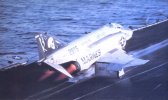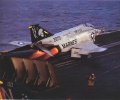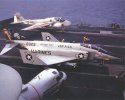I was going to say "I'll see your 3 engine fail to Fx at 105 and raise you a left engine out at rotation at 55k" but you seem to be fresh out of humor today..

Not really fresh out of humor, you have a penchant for using the website as a comedic and personal outlet. Hey, that's your style, I have no beef with that. But, you made a silly comment, and I called you on it. Nothing less than any of the TACAIR or Helo bubbas have done in previous posts when on a subject of their expertise.
Dumb question, why is a 3 engine at T/O so critical in a P3, you still have "more power per pound" trying to get the pig into the air than a 1 engined E2.
Not doubting you that its' nasty, I'm just wondering WHY it's nasty.
"More power per pound" is a wide open statement. If I am taking off with less than a ramp load, let's say 16k of fuel for an FCF, then, sure, I have more than enough available shaft horsepower, and more importantly, a higher three engine climb gradient. On the other end of the scale, if I am taking off on a 11 hour tactical flight at max gross weight, then I better be checking my planning numbers to check my decision speed, Vr and most importantly my three engine climb. Heck, maybe you have some low efficiency motors to boot! You factor in hot weather and high altitude airfields and you most definitely do NOT have power available even going to military power.
Just as with any multi-engine aircraft without centerline thrust, the loss of an engine during a takeoff roll, or touch and go situation has quite a few factors for the pilot to consider and correct immediately. Abort or takeoff? Remaining runway? If I abort, is it a prop malfunction that I need to shut down during my abort to eliminate any potential for continued positive thrust? If I rotate, what happened to the engine? Flameout, decouple, prop malfunction or a problem with fuel scheduling? Is the aircraft controllable, a spinning prop that didn't feather can decrease your climb and contrallablility.
Detecting the power loss, in our case, "seeing" the swerve off centerline with an engine failure resulting in an asymmetric power setting. Let's say a power loss on one, resulting in the aircraft wanting to depart the runway to the left. How wide is that runway? Were you on centerline to start with? My main mounts are farther apart than on the E2/C2, so I have less margin before one of those could depart the runway sides. What about winds? The crosswind component could be favorable or unfavorable. How fast are you going, do you have rudder authority? If the loss of power is at low speeds, then you more than likely can easily stop it on the runway using nose wheel steering and the remaining engines.
Depending on the severity of the power loss (low power loss to a complete loss of 3600SHP), a wrong rudder input could result in an immediate departure from the runway. The moment arm distance with a power loss on either our #1 or #4 engine will of course result in the greatest swerve. A hard correction back could result in a blown tire. We train to detecting the swerve, stopping it with rudder inputs (parallelling centerline) and slowly correcting back to a point at the end of the runway while waiting for rotate speed. That is of course assuming that you are above refusal. At training weights, the aircraft can rotate earlier than 115 knots if you are departing the runway. If you are heavier, you aren't going to get airborne until you hit your rotate speed. Additionally, the heavier the aircraft, the more "ponderous" (for want of a better word) it is to correct on the runway. You get enough weight moving in a given direction, it is more difficult to stop. Junior pilots are usually unprepared and over or under control a heavy plane on the take off roll. There is most definitely a different control handling of our plane at low versus high gross weights.
In my specific case during a pilot trainer, or ANY P3 instuctor pilot, you have a non-qualified pilot at the controls, with limited time at the controls, and an upgrading Flight Engineer. We were already off centerline to the left, prompting my student to correct back while we accelerated towards rotate when our power loss hit. The student was already feeding in right rudder when I pushed through his inputs and took the plane airborne. Training, regardless of platform pays huge dividends. There could have been a variety of uglier outcomes to the quite unexpected power loss resulting in a departure from the runway. Hours in the aircraft, FIUT and IUT training are all tools and training that helped me in this small case come prepared to handle it.
John

















